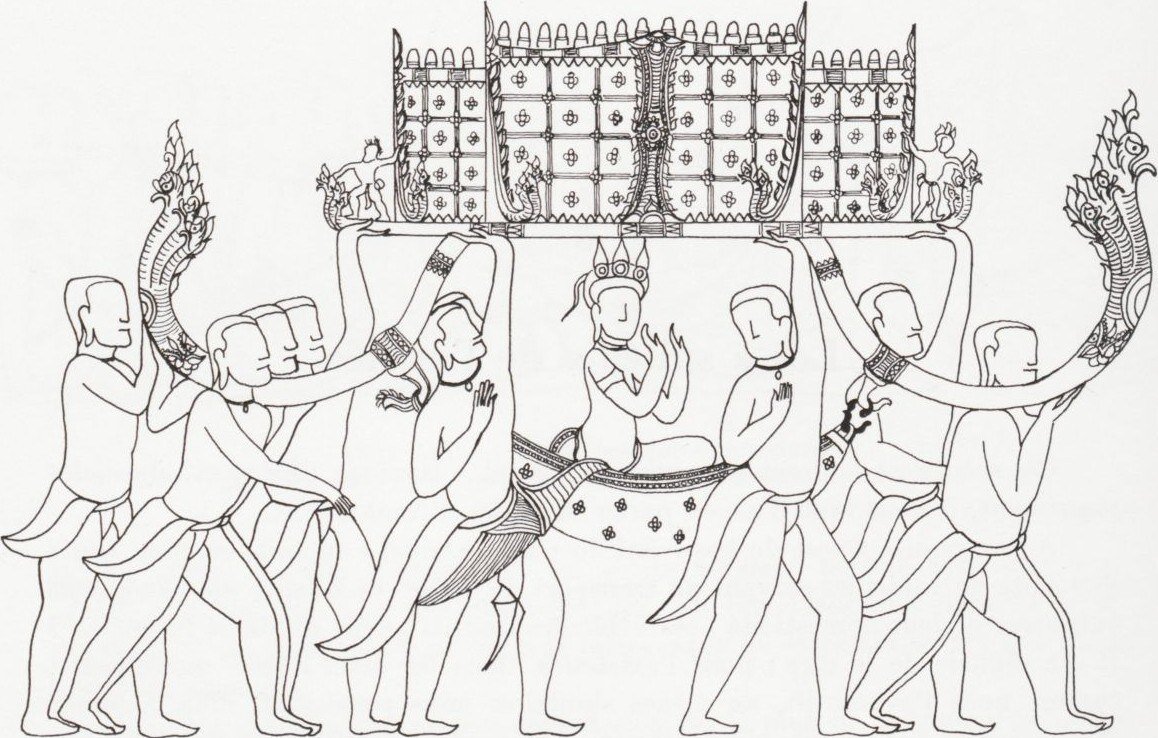L'armement et l'organisation de l'armée khmere au XIIeme et XIIIeme siecles | Khmer Weaponry and Military Structure 12th-13th centuries
by Michel Jacq-Hergoual'ch
How the rulers of Angkor borrowed from foreign technology and from local traditions to develop an original military structure

- Format
- on-demand books
- Publisher
- Musée Guimet Publications XII, Presses Universitaires de France, Paris
- Edition
- ebook by FeniXX
- Published
- 1979
- Author
- Michel Jacq-Hergoual'ch
- Pages
- 242
The author analyzed Angkorean bas-reliefs and inscriptions, developing earlier considerations by archaelogists and epigraphists, to portray the military structure of Angkor at his peak, noting that “nous devons aux sculpteurs khmers beaucoup de reconnaissance pour avoir su faire revivre ces scènes pleines de vie qui [rappellent] qu’aux XIIe et XIIIe siècles de notre ère, au Cambodge, on allait à la guerre en famille, la lance sur l’épaule et le bouclier à la main, dans une ambiance de kermesse, et que les lourds éléphants, que l’on s’appliquait à protéger de toute part, étaient surtout là pour impressionner l’adversaire bien plus que pour décider du sort des batailles qui n’étaient perdues ou gagnées que par les fantassins…” [We must be grateful to the Khmer sculptors for capturing those lively scenes which reminds us that, in 12th-13th centuries Cambodia, people would go to war en famille, spear on the shoulder and shield in hand, in a carnival-like atmosphere, and that the heavy elephants, protected from all sides, were meant more to scare the ennemy than to actually settle the outcome of batlles, won or lost only by the foot soldiers].
The author also remarks that horses, which had to be imported from India or China, and horse chariots, were never really used in battle; that “balistes” (ballistas) were a late addition to the military machine; that women, children, servants, kept company to the warriors, often acting as a supply corps even if the soldiers themselves were cooking their own meals.
One might lament that this ambitious and well-documented essay lacked an attempt of reflecting on military strategy during the heyday of the Khmer Empire.
email hidden; JavaScript is required
The author illustrated his essay with drawings from bas-reliefs studied by earlier scholars, for instance (above) a lady following the Khmer army in a palanquin (Angkor Wat bas-relief studied by George Coedès), and (below) foot soldiers, war elephant and supply aides (Banteay Chhmar bas-relief)
Full title: L’armement et l’organisation de l’armée khmere aux XIIe et XIIe siecles d’apres les bas-reliefs d’Angkor Vat, du Bayon et de Banteay Chmar
This book has been translated into English as The Armies of Angkor: Military Structure and Weaponry of the Khmers (translated by Michael Smithies, Bangkok: Orchid Press, 2007, 978−974−524−096−4)
Tags: military, Khmer Empire, battleships, wars
About the Author

Michel Jacq-Hergoual'ch
Michel Jacq-Hergoual’ch (1943, Brittany, France — 2014) was an historian and geographer who specialized in Indian and Indianized States of Southeast Asia studies, in particular the Khmer Empire and the Malay Peninsula, as well as ancient and modern history of Siam, and history of Art.
After studying under the guidance of Jean Boisselier and Madeleine Giteau, he was one of the first modern researchers who took interest in Khmer pagoda murals. In 2007, he bequeathed EFEO Photo Library his important photographic collection.
A former CNRS Research director, he explored Southeast Asian history, arts and culture in several publications, including Le Siam (Belles-Lettres, Paris, 2004). His 1979 book on L’armement et l’organisation de l’armée khmere aux XIIeme et XIII eme siecle has been translated into English as The Armies of Angkor: Military Structure and Weaponry of the Khmers (transl. Michel Smithies, Bangkok: Orchid Press, 2007).
See a bio-bibliography (in French)

